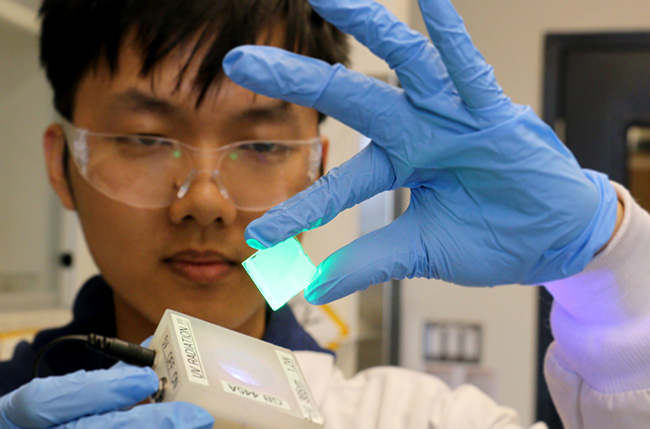
September 11, 2020
By Tyler Irving & Matthew Tierney
A new consortium — featuring players from industry, academia and government — will use the power of artificial intelligence (AI) to accelerate design of the next generation of high-performance materials, with applications from renewable energy to consumer electronics.
“Materials discovery has always started with what we find in nature. We combine and adapt found materials for properties like strength, elasticity and electrical conductivity,” says Professor Ted Sargent (ECE), the principal investigator of the new consortium. “But what if AI can help us flip this process on its head? Could we start from the properties we’re seeking, and work backwards?”
This is the paradigm-shifting goal of the Alliance for AI-Accelerated Materials Discovery (A3MD), which brings together world-leading researchers from the University of Toronto, McMaster University and the National Research Council of Canada, as well as industrial partners LG and TOTAL.
Together, the team aims to discover advanced materials, both to convert atmospheric CO2 into usable energy and to enhance the performance of consumer products such as bright and vivid displays.
The A3MD co-investigators include:
- Professor Alan Aspuru-Guzik (Chemistry, Computer Science, U of T)
- Professor Cathy Chin (ChemE)
- Professor Drew Higgins (McMaster University)
- Professor David Sinton (MIE)
- Isaac Tamblyn (National Research Council of Canada)
- Professor Alex Voznyy (Physical and Environmental Sciences, UTSC)
This multidisciplinary team will develop new strategies to address one of the key challenges in the discovery and synthesis of new materials: the immense size of the search space.
“The Materials Project, which aims to provide a computational library of known materials, currently predicts properties for over 700,000 of them,” says Aspuru-Guzik. “But those materials can be combined in myriad ways. There are simply too many possible permutations to try them all.”
Historically, the discovery of functional material has involved informed trial and error — and many trial tests. Moreover, the design of those experiments was subject to human bias: researchers tend to focus in on combinations of elements that their own experience suggest would be interesting.
In 2017, Aspuru-Guzik and Sargent, along with several other collaborators, issued a call to action in the journal Nature, arguing that emerging tools from the fields of AI and machine learning could play a key role in speeding up the search for new high-performance materials.
Properly trained algorithms can sort through vast libraries of simulated materials and recognize promising combinations in a fraction of the time, pointing researchers in fruitful directions.
Ultimately, these materials need to be synthesized and tested in the lab. And here too, AI can help: when combined with advanced robotics, it enables the use of high-throughput screening (HTS).
“With HTS, you can fabricate and test many different materials in parallel, rather than one at a time,” says Sinton. “Robotic devices take care of the repetitive lab work, doing it more quickly and repeatably. HTS is most powerful when guided using AI: each new iteration is informed by the analysis of the one that came before.”
The combination of AI and robotics provides rich opportunities for synergy that benefits all players.
“When looking for practical solutions on such a scale, it’s vital for researchers to cultivate partnerships with industry and other research institutions,” says ECE Chair Professor Deepa Kundur.
“A3MD is an excellent example of an initiative that actively engages perspectives to keep the focus on solutions that will make a tangible difference.”
In the first year, A3MD will put in place the needed infrastructure — including precision robotics — for high-throughput experimentation. The consortium will also convene several machine learning and data science bootcamps, training a new generation of experts, and will also organize a speaker series with leading researchers in the relevant fields. Graduate students and post-doctoral fellows will drive key aspects of the research and professional development strategy for the alliance.
In its second year, A3MD will expand further, adding industry and academic partners who bring additional expertise and offer new avenues to commercialize the novel technologies that will be developed.
“Partnerships are the backbone of innovation,” says Professor Alex Mihailidis, U of T’s Associate Vice-President of International Partnerships. “They find better solutions faster because they bring disparate groups together. A3MD is a great example of U of T’s spirit of collaboration and desire to work alongside such talented and invested partners.”
More information:
Jessica MacInnis
External Relations Manager
The Edward S. Rogers Sr. Department of Electrical & Computer Engineering
416-978-7997; jessica.macinnis@utoronto.ca